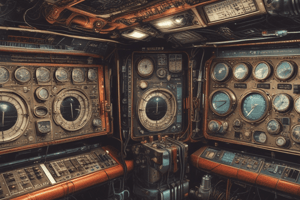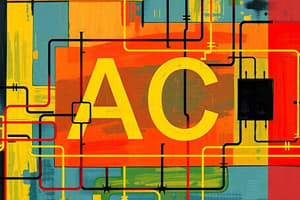Podcast
Questions and Answers
How does the firing angle of an SCR affect the average voltage delivered to a load in a half-wave power control circuit?
How does the firing angle of an SCR affect the average voltage delivered to a load in a half-wave power control circuit?
- It increases the average voltage
- It has no effect on the average voltage
- It decreases the average voltage (correct)
- It depends on the load impedance
In a full-wave power control circuit, how many thyristors are typically used?
In a full-wave power control circuit, how many thyristors are typically used?
- 3
- 1
- 4
- 2 (correct)
What happens to the SCR when the ac input goes negative in a half-wave power control circuit?
What happens to the SCR when the ac input goes negative in a half-wave power control circuit?
- It becomes forward-biased
- It turns off and does not conduct again until the trigger point on the next positive half-cycle (correct)
- It continues to conduct
- It becomes reverse-biased
What is the advantage of using an SCR in a half-wave power control circuit?
What is the advantage of using an SCR in a half-wave power control circuit?
How does the conduction angle of an SCR affect the average current delivered to a load in a half-wave power control circuit?
How does the conduction angle of an SCR affect the average current delivered to a load in a half-wave power control circuit?
What is the main advantage of SCS over SCR?
What is the main advantage of SCS over SCR?
What is the main characteristic of a DIAC?
What is the main characteristic of a DIAC?
In a full-wave power control circuit, what is the range of the firing angle θf?
In a full-wave power control circuit, what is the range of the firing angle θf?
What is the purpose of controlling the firing angle in a full-wave power control circuit?
What is the purpose of controlling the firing angle in a full-wave power control circuit?
What is the significance of the extinction angle θe in a full-wave power control circuit?
What is the significance of the extinction angle θe in a full-wave power control circuit?
Study Notes
Firing Angle and Conduction Angle
- Firing angle (θf) is the phase angle at which the SCR turns on.
- Conduction angle (θc) is the angle between the start and end of conduction.
- Example: θf = 90°, θc = 180° - 90° = 90°.
Half-Wave Power Control
- A common application of SCRs is in the control of ac power for lamp dimmers, electric heaters, and electric motors.
- A half-wave, variable-resistance, phase-control circuit is used to control the power.
- By adjusting R2, the SCR can be made to trigger at any point on the positive half-cycle of the ac waveform between 0° and 90°.
Full-Wave Power Control
- Similar to half-wave power control, but either one of the SCRs are conducting in either positive or negative cycle of the input signal.
- Average Voltage: VAVE = Vm / π (1 + cosθf)
- Average Current: IAVE = VAVE / RL
SCR Applications
- On-Off Control of Current: SCR circuit that permits current to be switched to a load by the momentary closure of switch SW1 and removed from the load by the momentary closure of switch SW2.
- Half-Wave Power Control: used in lamp dimmers, electric heaters, and electric motors.
- Full-Wave Power Control: used in similar applications to half-wave power control.
- Crowbar: used to protect a load from overvoltage.
SCR Crowbar
- A power supply of VCC is applied to a protected load.
- Under normal conditions, VCC is less than the breakdown voltage of the zener diode.
Silicon-Controlled Switch (SCS)
- Similar to SCR.
- Has two gate terminals, cathode and anode gate.
- Four-terminal thyristor used to trigger the device ON and OFF.
- Faster turn-off time than SCR.
- Used in counters, registers, and timing circuits.
How to turn on SCS
- A positive pulse applied on the cathode gate or a negative pulse applied on the anode gate.
How to turn off SCS
- A positive pulse applied on the anode gate or a negative pulse applied on the cathode gate.
- Reducing the anode current below the holding current by using BJT as a switch to interrupt anode current.
DIAC
- Two-terminal four-layer thyristor which conducts in EITHER direction when properly activated.
Studying That Suits You
Use AI to generate personalized quizzes and flashcards to suit your learning preferences.
Related Documents
Description
Quiz on AC circuits, covering firing angle, conduction angle, and average current calculations. Topics include trigonometry and electrical engineering principles.




